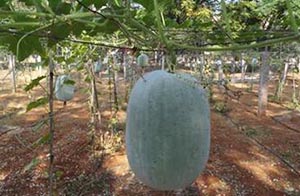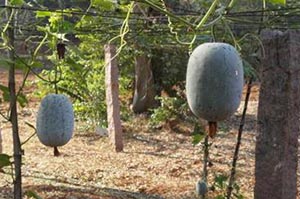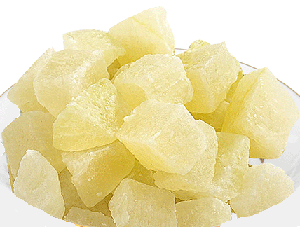Ash gourd (Chinese winter melon) nutrition facts
Ash gourd is a large, round to oval fruit pod in the cucurbitaceae family that is eaten as a cooked vegetable and in the confectionary in many Asian countries.
Its pods are fuzzy when immature and develop gray, waxy matter on their surface upon maturity; hence the name ash or wax gourd. Ash gourd is also known by various names such as white gourd, white pumpkin, winter gourd, winter melon, Chinese preserving melon, pith gourd, tallow gourd, and Chinese watermelon.
Scientific name: Benincasa hispida. It is the only member of the genus Benincasa.
 |
| Ash gourd. Note for gray, waxy skin. |
Ash gourd is an annual vine and has similar growth characteristics as other gourd vegetables. Clay-mixed organic soil is best suited for its growth. Trellis support is required for better yield. Upon pollination, golden-yellow flowers develop into large, ovate pods which further develop to achieve maturity in 100-140 days depending upon cultivar varieties. Mature pods can weigh 15-20 pounds.
 |
| Ash gourd. Pole cultivation. |
Externally, the ash gourd pods feature a tough, green skin that is coated with a layer of white chalky wax. Tiny, fuzzy hairs on the surface will gradually disappear as the fruit matures. On its interior, the thick flesh is white, crisp, and juicy, and has a mild, cucumber-like taste.
Ash gourd seeds resemble like that of pumpkins; are oval, flat, and light brown.Health benefits of Ash gourd
Ash gourd is a very low-calorie vegetable; just holds 13 cal/100g, relatively the same calories as in cucumbers (12 cal/100g). Nonetheless, it carries ample concentrations of vitamins, minerals, and fiber that help in overall health and wellness.
Winter melon peel is a good source of dietary fiber which helps in smooth bowel movements and offers protection against colon cancers by eliminating toxic compounds from the gut.
Ash gourd is gluten-free food item and is one of the better alternative food substitutes for people suffering from a spectrum of gluten-related disorders. Gluten is a protein molecule in foods that causes severe food intolerance in non-celiac (gluten sensitivity) as well as celiac disease patients.
Fresh Ash gourd holds relatively more amounts of vitamin-C (14% of RDA /100 g) than cucumbers. Vitamin C is a water-soluble antioxidant that plays a role as an immunity booster, collagen synthesis in bones, cartilage, and blood vessels, and aids in the absorption of iron.
It provides small amounts of (5 μg/100 gm) of folates. Folate is an essential element for cell division and DNA synthesis. When taken adequately during early pregnancy, it may help prevent neural tube defects in the newborn.
Like-wise in winter squash varieties, ash gourd too holds less sodium (6 mg/100 g) but higher amounts of potassium (111 mg/100 g), an important intra-cellular electrolyte. Potassium is a heart-friendly electrolyte and helps bring the reduction in blood pressure and heart rates by countering the pressing effects of sodium.
Further, Ash gourd carries modest levels of other B-complex groups of vitamins like pantothenic acid, and riboflavin, and minerals like calcium, iron, manganese, phosphorus, and zinc.
In traditional Ayurvedic medicine, ash gourd (white pumpkin) has been thought to be alkaline in nature, and hence its consumption has a cooling and neutralizing effect on stomach acids and as such used effectively for treating digestive ailments like hyperacidity, dyspepsia, and ulcers. It is also used to treat diabetes.
| Principle | Nutrient Value | Percent of RDA |
|---|---|---|
| Energy | 13 Kcal | 1% |
| Carbohydrates | 3g | 2.3% |
| Protein | 0.4 g | <1% |
| Total Fat | 0.2 g | 1% |
| Cholesterol | 0 mg | 0% |
| Dietary Fiber | 2.9 g | 7.6% |
| Vitamins | ||
| Folates | 5 μg | 1.25% |
| Niacin | 0.400 mg | 2.5% |
| Pantothenic acid | 0.133 mg | 2.5% |
| Pyridoxine | 0.035 mg | 3% |
| Riboflavin | 0.11 mg | 1% |
| Thiamin | 0.04 mg | 3.3% |
| Vitamin-A | 0 IU | 0% |
| Vitamin-C | 13 mg | 14% |
| Electrolytes | ||
| Sodium | 6 mg | <0.5% |
| Potassium | 111 mg | 2.4% |
| Minerals | ||
| Calcium | 19 mg | 2% |
| Iron | 0.4 mg | 5% |
| Magnesium | 10 mg | 2.5% |
| Manganese | 0.058 mg | 2.5% |
| Phosphorus | 19 mg | 2.5% |
| Selenium | 0.2 μg | <1% |
| Zinc | 0.61 mg | 6% |
Selection and storage
Ash gourd is available around the year in the Asian markets. Buy fresh, average-sized fruit with an intact stem. Avoid any if spotted with surface blemish, damage, cuts/punctures, etc.
At home, wax gourds keep for 4 to 6 months or more if stored in a cool dry place.
Cut sections, however, should be used in cooking immediately. If you choose to keep it for extended use (up to 1-2 days only), then place it inside a plastic wrap in the refrigerator set at high relative humidity.
Preparation and serving methods
Wax gourds are popular winter melons in many parts of East and South-East Asian countries. They are consumed in different ways such as cooked fresh vegetables, dried, and pickled. Also, it is used raw in salads, in a way similar to cucumbers.
At home, wash fruits in cold water to remove any surface dirt. Trim at the stem end. Being a winter squash member, Ash gourd has a tough skin that should be peeled using a knife. Cut the fruit into small cubes, wedges, or just in halves as you may desire to use them in cooking.
It is employed in a variety of recipes as diced, stuffed, grilled, roasted in soups, curries, stews, casseroles, etc.
In many East-Asian communities, ash gourd flowers, baby fruits, and young tender shoots and tendrils are also an edible delicacy. In general, male blossoms are picked up for making fritters, stuffing, etc. To prepare, open up flowers and remove if any, insects. Pull off any calyces attached firmly at the base.
 |
| Agra petha, dry |
Here are some serving tips:
Fresh, tender ash gourd cubes/slices can be eaten raw in salads.
In mainland China, winter melon is one of the most sought-after vegetables. Its chunks are used in soup with braised pork belly, red dates (jujube) and served with chopped spring onions.
In the Southern parts of China, winter melon pulp is mixed with almond paste, sesame and five spice powder to prepare Cantonese style pastry- also popular as wife cake or sweetheart cake.
As in pumpkin, it can be employed in pies, casseroles, cakes, pudding, etc.
In India, ash gourd is employed in curries (poosanikai kootu), soup, stews and raitha.
Its flesh used in the preparation of sweet dishes like halwa and candies (petha) in northern states of India. In the North Indian city of Agra, boiled and drained wax gourd pulp is candied with sugar and seasoned with saffron (kesar petha) or raisins (angoori petha) to prepare a delicious sweet.
Ash gourd kernels can be eaten as a snack like pumpkin seeds. Simply toast the seeds in the oven and enjoy!
In India, ash gourd (white pumpkin-safed petha) is juiced and consumed for its refreshing, cooling effects in a similar way to cucumber juice.
Safety profile
Ash gourd consumption rarely causes allergic reactions. (Medical disclaimer).
Also read ≺≺-
≻≻- Crookneck squash nutrition facts.
≻≻- Bottle gourd nutrition facts.
≻≻- Back to Vegetables from Ash gourd (winter melon) nutrition. Visit here for an impressive list of vegetables with complete illustrations of their nutrition facts and health benefits.
≻≻- Back to Home page.
Further reading:
Asian melons (PDF).